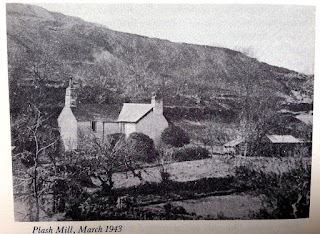In search of a poet
Frances Bellerby
Frances Bellerby
lived at Plash Mill, near Upton Cross, on the edge of Bodmin Moor. Although few
now have heard of her, she deserves to be read by all who find Cornwall in
general and the moor in particular a mysterious and special place. Charles
Causley, the foremost Cornish poet, championed her work. In his introduction to his selection of her
verse *, he wrote of how she settled ‘at Plash Mill, under the louring shadow
of Caradon Hill’, and how for eleven years she lived and wrote ‘in a haunted
and haunting Cornish landscape. Here, in
this particular area of Cornwall, are neolithic stone circles, medieval holy
wells, ivied engine-houses crumbling away in a memory of the great nineteenth-century
copper mines and their appalling conditions of labour. Nearby, too, is Cornwall’s frontier river
valley of the Tamar that flows to Plymouth, with all its associations of war
and the sea. The whole district is as
heavy with history as the air with the mists and rains of Bodmin Moor.’ Her poetry, he said, contained ‘the ambience,
and the essence of place’ of this bleakly beautiful land.
The wind leapt, mad-wolf, over
the rim of the moor
at a single bound, and with furious uproar
fell on the tree-ringed house by the deep-cut stream -
Quiet little house, standing alone
blind, old, pale as the moon
and sunk in some ancient grassy dream.
Plash Mill, Under The Moor
at a single bound, and with furious uproar
fell on the tree-ringed house by the deep-cut stream -
Quiet little house, standing alone
blind, old, pale as the moon
and sunk in some ancient grassy dream.
Plash Mill, Under The Moor
It was in this ‘quiet little house’ that the muse came to Frances
Bellerby. ‘I remember very clearly the
Presence in the lamp-lit room, the tremendous, deep, still excitement, the
immediate writing down of the dictated words.’
As well as poetry there was prose: short stories, and notebooks in which
she recorded her impressions of the constantly changing moor; this entry, made in the early spring of 1950, is quoted by Robert Gittings in his biographical introduction to a later selection of her work*:
The colour of the steeply rising
ploughed field seems to reflect in the whole day. A delicate shining March day, of a peculiar fawn colour, almost a sand colour. There is pink in it. I have seen that field under snow, and under
grass, year in year out, and under the heavy, violet, wet winter earth. I have seen the great carthorses flourish and
play there, shining, grey and bay. And
the red heifers, brilliant in the evening, their shadows long before them. And the jackdaws ink on gold …
The inky outlines of birds is an image she returns to in the
poem ‘What Then?’
Men never come this way. In winter
the steep lane is a stone-jagged stream.
Leaves lie in deep drifts
tawny-orange, fulgent;
flattened leaves, brilliant, cling to the water-barrel,
one or two still slashed with sharpest green.
The lichen-furred branches of the apple-trees
without movement criss-cross the sad white sky
whilst in those clear frail heights of the seven beeches
ink-shapes of rooks sway gently, far away
as childhood.
the steep lane is a stone-jagged stream.
Leaves lie in deep drifts
tawny-orange, fulgent;
flattened leaves, brilliant, cling to the water-barrel,
one or two still slashed with sharpest green.
The lichen-furred branches of the apple-trees
without movement criss-cross the sad white sky
whilst in those clear frail heights of the seven beeches
ink-shapes of rooks sway gently, far away
as childhood.
But childhood, while far away, is rarely banished entirely from
one’s memory, as the poem makes plain:
Men do not come this way. The
leaf-patterned grass
seems likely to have its will for ever now,
and the broken gate swing on in the yellow wind,
and bright holly berries make annual festival
for mice and birds, but never mysterious gleam
in dark-and-silver rooms.
This whole place has been
forgotten, I think: - is part of someone’s past,
part of some childhood now obscured
by the strange thick dream that life becomes
as we live on. Surely there’s someone groping,
struggling with muffling veils, baffled by half-glimpses
caught from sight, scent or sound. And at last, in the
moment of dying
perhaps, the struggler will break through,
return … Then what of me?
seems likely to have its will for ever now,
and the broken gate swing on in the yellow wind,
and bright holly berries make annual festival
for mice and birds, but never mysterious gleam
in dark-and-silver rooms.
This whole place has been
forgotten, I think: - is part of someone’s past,
part of some childhood now obscured
by the strange thick dream that life becomes
as we live on. Surely there’s someone groping,
struggling with muffling veils, baffled by half-glimpses
caught from sight, scent or sound. And at last, in the
moment of dying
perhaps, the struggler will break through,
return … Then what of me?
In the early summer of 2018, I took a trip to Plash Mill.
The house is still there – now surrounded by trees, which were not there in the
poet’s day. There are still, also, paths where ‘the broken gate swings on in
the yellow wind.’ Wonderful, like her poetry.
*Frances Bellerby: Selected Poems, with an Introduction by Charles Causley, Enitharmon Press 1970
*Selected Poems, Frances Bellerby, Selected and Edited by Ann Stevenson with a Biographical Introduction by Robert Gittings, Enitharmon Press, 1986
*Selected Poems, Frances Bellerby, Selected and Edited by Ann Stevenson with a Biographical Introduction by Robert Gittings, Enitharmon Press, 1986






Comments
Post a Comment